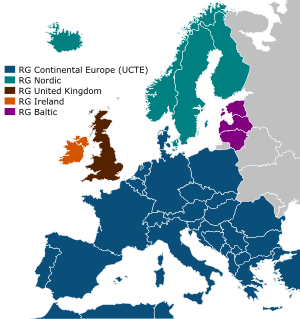Synchronous grid of Continental Europe
The synchronous grid of Continental Europe (also known as Continental Synchronous Area; formerly known as the UCTE grid) is the largest synchronous electrical grid (by connected power) in the world. It is interconnected as a single phase-locked 50 Hz mains frequency electricity grid that supplies over 400 million customers in 24 countries, including most of the European Union. In 2009, 667 GW of production capacity was connected to the grid, providing approximately 80 GW of operating reserve margin.[1] The transmission system operators operating this grid formed the Union for the Coordination of Transmission of Electricity (UCTE), now part of the European Network of Transmission System Operators for Electricity (ENTSO-E).
.png)

Area
The synchronous grid of Continental Europe covers territory of the ENTSO-E Continental Europe regional group and some neighboring countries not involved in the ENTSO-E. The synchronous grid includes part or all of Austria, Belgium, Bosnia and Herzegovina, Bulgaria, Croatia, Czech Republic, Denmark (western part), France, Germany, Greece, Hungary, Italy, Luxembourg, Montenegro, the Netherlands, North Macedonia, Poland, Portugal, Romania, Serbia, Slovakia, Slovenia, Spain, and Switzerland as a members of the ENTSO-E Continental Europe regional group. In addition to the ENTSO-E members, the small west electricity island of Ukraine is synchronized with the grid of Continental Europe. Albania is operating the national grid synchronously with the synchronous grid of Continental Europe. The grids of Morocco, Algeria and Tunisia are synchronized with the European grid through the Gibraltar AC link and form the SWMB. In April 2015, the grid of Turkey was synchronized with the European grid.[2]
Although synchronous, some countries operate in a near island mode, with low connectivity to other countries. The European Commission considers high connectivity to be beneficial,[3] and has listed several interconnection projects as "Projects of Common Interest".[4] However, the national grids must also be upgraded to handle increased power flows if the values of a free energy market are to be realised in the EU.[5]
List of electricity interconnection level
Electricity interconnection as percentage (EIL = electricity interconnection level) of installed electricity production capacity in 2014; the EU has a goal of at least 10%.[3]
| Country | EIL |
|---|---|
| Luxembourg | 245% |
| Croatia | 69% |
| Slovenia | 65% |
| Slovakia | 61% |
| Denmark | 44% |
| Hungary | 29% |
| Austria | 29% |
| Sweden | 26 % |
| Belgium | 17% |
| Netherlands | 17% |
| Czech Republic | 17% |
| Greece | 11% |
| Bulgaria | 11% |
| Germany | 10% |
| France | 10% |
| Ireland | 9% |
| Italy | 7% |
| Romania | 7% |
| Portugal | 7% |
| Poland | 4% |
| Spain | 2% |
| Cyprus | 0% |
Electricity island networks
The British grid is not synchronized with the Continental Europe frequency, but it is inter-connected using high-voltage direct current (HVDC) via the HVDC Cross-Channel link, BritNed and Nemo Link. In 2014, before Nemo Link became operational, the UK electricity interconnection level was 6%.[3] Similarly, the Nordic regional group of ENTSO-E (former NORDEL), composed of Norway, Sweden, Finland and the eastern part of Denmark (Zealand with islands and Bornholm), is not synchronized with the Continental Europe, but has a number of non-synchronous DC connections with the Continental Europe grid. Gotland is not synchronized with the Swedish mainland, as it is connected by HVDC.
The networks of Ireland and Northern Ireland form the ENTSO-E Irish regional group, which is not yet interconnected with the Continental Europe grid, but has DC interconnections with the British network through the HVDC Moyle Interconnector and the East–West Interconnector. Similarly, the network of ENTSO-E Baltic regional group, composed of Lithuania, Latvia and Estonia, currently part of the IPS/UPS system, is interconnected with the Nordic grid at an electricity interconnection level of 10% through the Estlink cables and the NordBalt cable, which is functioning since 2015.[3] The Baltics are also connected with the Continental Europe grid through the Lithuania–Poland interconnection.
The networks of Iceland and Cyprus are not yet interconnected with the other grids. Malta is connected up to 35% via the Malta-Sicily interconnector, commissioned in 2015.
Future extension plans
UCTE/ENTSO-E and the corresponding partner TSO companies are planning the following extensions of the grid and synchronous frequency:
- UCTE-Ukraine/Moldova, to disconnect only these networks from the IPS/UPS system and synchronously interconnecting them to the synchronized grid of Central Europe[6]
- Tunisia-Libya synchronous connection, that would extend the Continental Europe frequency to Libya, Egypt, Jordan, Syria and Lebanon (the latter five countries constitute the SEMB of the Mediterranean Electricity Ring project.
- Syria-Turkey interconnection, completing the Mediterranean ring.
Studies are made on the synchronous connection between the Continental Europe and IPS/UPS networks . Separately, there is another option concerning Ukraine and Moldova, and the ENTSO-E Baltic regional group – to disconnect only these networks from the IPS/UPS system and synchronously interconnecting them to the synchronized grid of Central Europe. Further possibilities are extension to the Nordic regional group, the Turkey-Iraq interconnection, and the DESERTEC concept for interconnection with other countries in the Middle East. In the past Armenia and Turkmenistan networks were part of the Soviet unified system, but currently they are connected to the Iran grid.
See also
- SuperSmart Grid – proposal for a wide area synchronous grid combining European, IPS/UPS and Middle East networks
- Super grid
- European super grid
References
- UCTE Annual REport 2008
- "ENTSO-E at a Glance" (PDF). ENTSO-E. June 2015.
- COM/2015/082 final: "Achieving the 10% electricity interconnection target" Text PDF page 2-5. European Commission, 25 February 2015. Archive Mirror
- "Union list of projects of common interest" page 10. European Commission, 18 November 2015.
- http://www.acer.europa.eu/Official_documents/Acts_of_the_Agency/Publication/ACER_Market_Monitoring_Report_2015.pdf
- "Regional Group Continental Europe". Archived from the original on 31 May 2013.